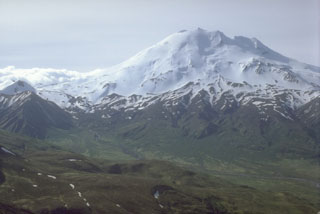Report on Chiginagak (United States) — August 1998
Bulletin of the Global Volcanism Network, vol. 23, no. 8 (August 1998)
Managing Editor: Richard Wunderman.
Chiginagak (United States) Ash, gas-and-steam plume on 13 August
Please cite this report as:
Global Volcanism Program, 1998. Report on Chiginagak (United States) (Wunderman, R., ed.). Bulletin of the Global Volcanism Network, 23:8. Smithsonian Institution. https://doi.org/10.5479/si.GVP.BGVN199808-312110
Chiginagak
United States
57.135°N, 156.99°W; summit elev. 2221 m
All times are local (unless otherwise noted)
Residents of the town of Pilot Point and personnel of the U.S. Fish and Wildlife Service reported on 13 August that the usual white steaming of Chiginagak fumaroles had changed for a time. The volcano had begun to issue puffs of black ash accompanied by a greenish-yellow gas-and-steam plume that rose 150-300 m above the summit. By the following morning a dusting of black ash was observed on fresh snow on the upper part of the volcano. The plume had reverted to white steam. The activity was not substantial enough to be detected by satellite imagery. The Alaska Volcano Observatory has no seismic instruments at the site.
Geological Summary. The symmetrical, glaciated Chiginagak stratovolcano locatedon the Alaska Peninsula ~15 km NW of Chiginagak Bay contains a small summit crater, which is breached to the south, and one or more summit lava domes. Lava domes occur high on the NW and SE flanks of the calc-alkaline volcano. An unglaciated lava flow and an overlying pyroclastic-flow deposit extending E from the summit are the most recent eruption products, which most likely originated from a lava dome on the SE flank, 1 km from the summit. Brief ash eruptions were reported in July 1971 and August 1998. Fumarolic activity has bene reported on the NE flank, and two areas of hot-spring travertine deposition are located at the NW base near Volcano Creek.
Information Contacts: Alaska Volcano Observatory (AVO), a cooperative program of a) U.S. Geological Survey, 4200 University Drive, Anchorage, AK 99508-4667, USA (URL: http://www.avo.alaska.edu/), b) Geophysical Institute, University of Alaska, PO Box 757320, Fairbanks, AK 99775-7320, USA, and c) Alaska Division of Geological & Geophysical Surveys, 794 University Ave., Suite 200, Fairbanks, AK 99709, USA.

